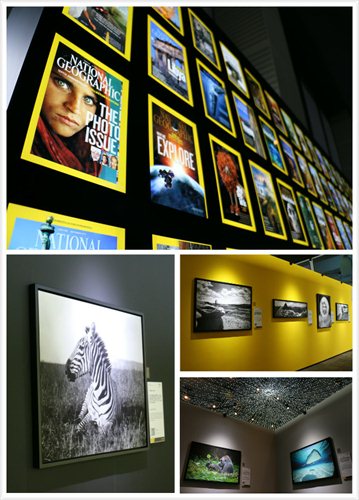A natural history
Exhibition charts the adventures of the National Geographic magazine
At a time when for many, the closest they'd get to adventure travel was reading Around the World in Eighty Days, photographers of the National Geographic Society were visiting every corner of the world and charting its geography and cultures.
Founded in Washington, D.C., in 1888, the scientific and educational institution has been a medium for disseminating the findings of explorers and anthropologists.
Nine months after the society itself was founded, its official magazine National Geographic published its first issue.
The magazine is known for its yellow square border, dramatic photos and contribution to deepening our understanding of the world we live in.
The exhibition A New Age of Exploration: National Geographic aims to revisit the dramatic moments and scenes charted by the magazine through its history with a selection of some 100 photos from the magazine's archive, including some photos featuring the old Shanghai.

A New Age of Exploration: National Geographic features some 100 photos from the magazine's archive. Photos: Courtesy of the exhibition venue
Into the unknown
The photos document many world firsts in terms of the discovery of our planet and the evolution of technology.
The first outdoor photograph in the National Geographic was published in 1890. It depicted a dull stretch of treeless land on Herald Island, Alaska.
The publication of this and other early photographs in the late 19th century marked a turning point for the magazine.
National Geographic founders hoped the images could stimulate geographic investigation as well as prove an acceptable medium for the publication of the results of such ventures.
The first years of the 20th century then saw a series of breakthroughs, including the first underwater photography taken in 1927 by William Longley and Charles Martin.
The tools they used were not advanced, and even dangerous by today's standards: a brassbound waterproof camera and explosive flash powder.
Though Longley got seriously burned and the fish appeared a bit ghostly, they got their photos.
A 1934 issue off the coast of Bermuda saw a photographer use a bathysphere, resembling the craft depicted in H.G. Well's 1895 story In the Abyss, to get the shots.
The exhibition also showcases a photo of the last resting place of the Titanic taken by Emory Kristof.
A pioneer of innovative, high-tech underwater photography, Kristof created the preliminary designs of the electronic camera system for the remotely controlled deep sea vehicle Argo, which found the Titanic in 1985.
The wreck was found about 600 kilometers south-southeast of the coast of Newfoundland, lying at a depth of about 3.8 kilometers.
Taken in 1991 using high-intensity lighting systems, the photo brings the Titanic to life from the depth of the ocean. It shows the vessel looming out of the deep water, covered in thick rust.
Filmmaker James Cameron is also a National Geographic explorer-in-residence.
A photo in the exhibition shows him emerging from his submersible, Deepsea Challenger, in which he set the world record for deepest solo dive by reaching the 11-kilometer deep Mariana Trench.
Iconic image
As well as exploring the natural world, the photos also cover the plight of different lands and there peoples.
One of the most famous human cover images is titled Afghan Girl (pictured top left). The image features a young woman in a red headscarf looking alertly at the camera with her haunting green eyes.
It was taken by National Geographic photographer Steve McCurry when he was stationed at the Afghanistan-Pakistan border to cover the refugee crisis in December 1984. Millions of refugees were fleeing to Pakistan to escape fighting.
In one of the refugee camps near Pakistan, McCurry found the 12-year-old girl with incredible eyes. He took a photo of her. She then became the iconic Afghan Girl.
Since the photo appeared on the cover of the National Geographic in June 1985, her piercing stare, scrutiny and youthful innocence have challenged the world.
Her image has appeared in magazines, books and posters as an emblem of refugees and women.
Despite the huge impact of her image, no one knew her identity until McCurry tracked her down again in 2002.
This is when the world first discovered that her name is Sharbat Gula. Along with her grandmother, brother, and three sisters, she walked across the mountains to Pakistan and ended up in the Nasir Bagh refugee camp in Pakistan in 1984. Her parents died when she was 6.
Gula now lives with her husband and three daughters in a remote area of Afghanistan. According to McCurry, Gula had no idea her face had become an icon. However, she still remembers the experience of being photographed as she had her photo taken on just two occasions - once in 1984, and once on her reunion with McCurry.
Date: Until March 1, 9 am to 9 pm
Venue: 94/F, Shanghai World Financial Center
Address: 100 Century Avenue
世纪大道100号
Admission: 180 yuan ($27.36)
Call 4001-100-555 for details
Global Times